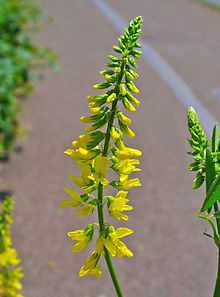Melilotus officinalis
| Melilotus officinalis | |
|---|---|
 | |
| Scientific classification | |
| Kingdom: | Plantae |
| (unranked): | Angiosperms |
| (unranked): | Eudicots |
| (unranked): | Rosids |
| Order: | Fabales |
| Family: | Fabaceae |
| Subfamily: | Faboideae |
| Tribe: | Trifolieae |
| Genus: | Melilotus |
| Species: | M. officinalis |
| Binomial name | |
| Melilotus officinalis (L.) Pall. | |
Melilotus officinalis, known as yellow sweet clover, yellow melilot, ribbed melilot and common melilot, is a species of legume native to Eurasia and introduced in North America, Africa and Australia.
Description
Melilotus officinalis is biennial plant is 4–6 feet (1.2–1.8 m) high at maturity. The plant has a bitter taste.
It blooms in spring and summer. Flowers are yellow. Its characteristic sweet odor, intensified by drying, is derived from coumarin.
Ecology
This plant is very common as it can adapt itself to various soils (but especially likes alkaline soils) and climates. It is resistant to drought and has abundant seed production. In some habitats it is an invasive species. Common places where it can be found include prairies, abandoned fields, roadsides, and railroad ballasts. It does not tolerate dense shade.
Toxicology
Sweet clover contains coumarin that converts to dicoumarol (a powerful anticoagulant toxin) when the plant becomes moldy. This can lead to bleeding diseases (internal hemorrhaging) and death in cattle. Consequently, hay containing the plant must be properly dried and cured, especially in wet environments.[1]
Uses
In the chemical industry, dicoumarol is extracted from the plant to produce rodenticides.[citation needed]
Horticulture
This plant is mainly used for agricultural purposes. It is grown as hay despite its toxic properties when moldy. It is considered an excellent green manure.
Sweet clover is a major source of nectar for domestic honey bees.
Flowers and seeds can be used as flavoring. [citation needed]
Phytoremediation
Melilotus officinalis has been used as a phytoremediation—phytodegradation plant for treatment of soils contaminated with dioxins. [2]
References
- ↑ Nicole Kresge, Robert D. Simoni, and Robert L. Hill. "Hemorrhagic Sweet Clover Disease, Dicumarol, and Warfarin: the Work of Karl Paul Link". Retrieved 2009-08-11.
- ↑ Sandia National Labs: SSFL Report; pg.10 . accessed 6.12.2012
| Wikimedia Commons has media related to Melilotus officinalis. |
External links
| Wikispecies has information related to: Melilotus officinalis |